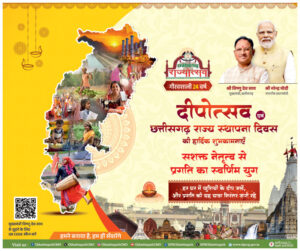Chhattisgarh is on a Rapid Path to Progress, emerging as a Healthy and Youthful State
HNS24 NEWS November 8, 2024 0 COMMENTS
It is a well-known fact that a healthy mind resides in a healthy body, and that a person’s greatest wealth is their health. The youth of Chhattisgarh understands this concept well, as the state—now in its 25th year—is not only vigilant about health but also alert to adopting new technology. The state’s dedication to health is evident in its ambitious plan to double its health budget in the coming years. In 2023-24, the health budget of Chhattisgarh was Rs 5,461 crore, which has now been increased by 38.5% to Rs 7,563 crore for 2024-25.
When Chhattisgarh was a newly-formed state, it faced numerous health challenges. The maternal mortality rate was alarmingly high, institutional deliveries were almost nonexistent, and in regions like Bastar, malaria claimed more lives than insurgency-related incidents. Without ambulance services, timely medical treatment was inaccessible to many. However, these issues now belong to a past era for the youthful Chhattisgarh of today. In 2003, the maternal mortality rate was 269 per 100,000, a figure that has since dropped to 137.
According to the National Family Health Survey-3 (2005-06), only 15.3% of deliveries in the state took place in healthcare institutions. This figure has now surged by nearly 70%, reaching 85.7% as per National Family Health Survey-5 (2019-21). Malaria cases in Bastar have reduced by 50% since 2018, and the 108 Sanjeevani ambulance service has proven to be a lifeline for the state’s residents. Over the past year alone, 9,73,681 emergency calls were received on the 108 hotline, benefitting 3,04,847 patients.
Through the Shaheed Veer Narayan Singh Ayushman Health Scheme, 7.72 million families in Chhattisgarh are entitled to free medical treatment worth up to Rs 5 lakh, with plans to extend this coverage to Rs 10 lakh. Under the Chief Minister’s Special Health Assistance Scheme, financial assistance of up to Rs 25 lakh is provided for specific medical conditions, with Rs 43 crore already disbursed to nearly 1,200 beneficiaries as of September 12, 2024.
Ensuring the health of Chhattisgarh’s population requires a well-equipped medical workforce. Yet, 24 years ago, the state had only one government medical college with 100 MBBS seats. Today, there are 10 government medical colleges, with a total of 1,460 MBBS seats, along with 291 postgraduate seats, enabling the state to develop a pool of skilled specialist doctors.
Chhattisgarh is now focused not only on hospitals but also on establishing super-specialty facilities. The state’s first digital budget outlined a plan to set up SIMS (Super-Specialty Institute of Medical Sciences) in each division, modeled after AIIMS, with Bilaspur already witnessing the inauguration of its SIMS on Dhanvantari Day by Prime Minister Narendra Modi. In the near future, Chhattisgarh is set to pioneer organ transplants within the state.
Chhattisgarh, which was once classified as a ‘BIMARU’ (underdeveloped) state when it was formed on November 1, 2000, is now a thing of the past. The current government, led by Chief Minister Vishnu Deo Sai, recognizes the importance of achieving a developed status for Chhattisgarh by 2047, in line with India’s national aspirations. Health remains the crucial foundation for creating an empowered and prosperous state, and the current administration’s continuous efforts are yielding visible progress toward this vision.
RELATED ARTICLES
R.O,No: 13028/174

R.O,No: 13028/174

R.O,No: 13028/174




